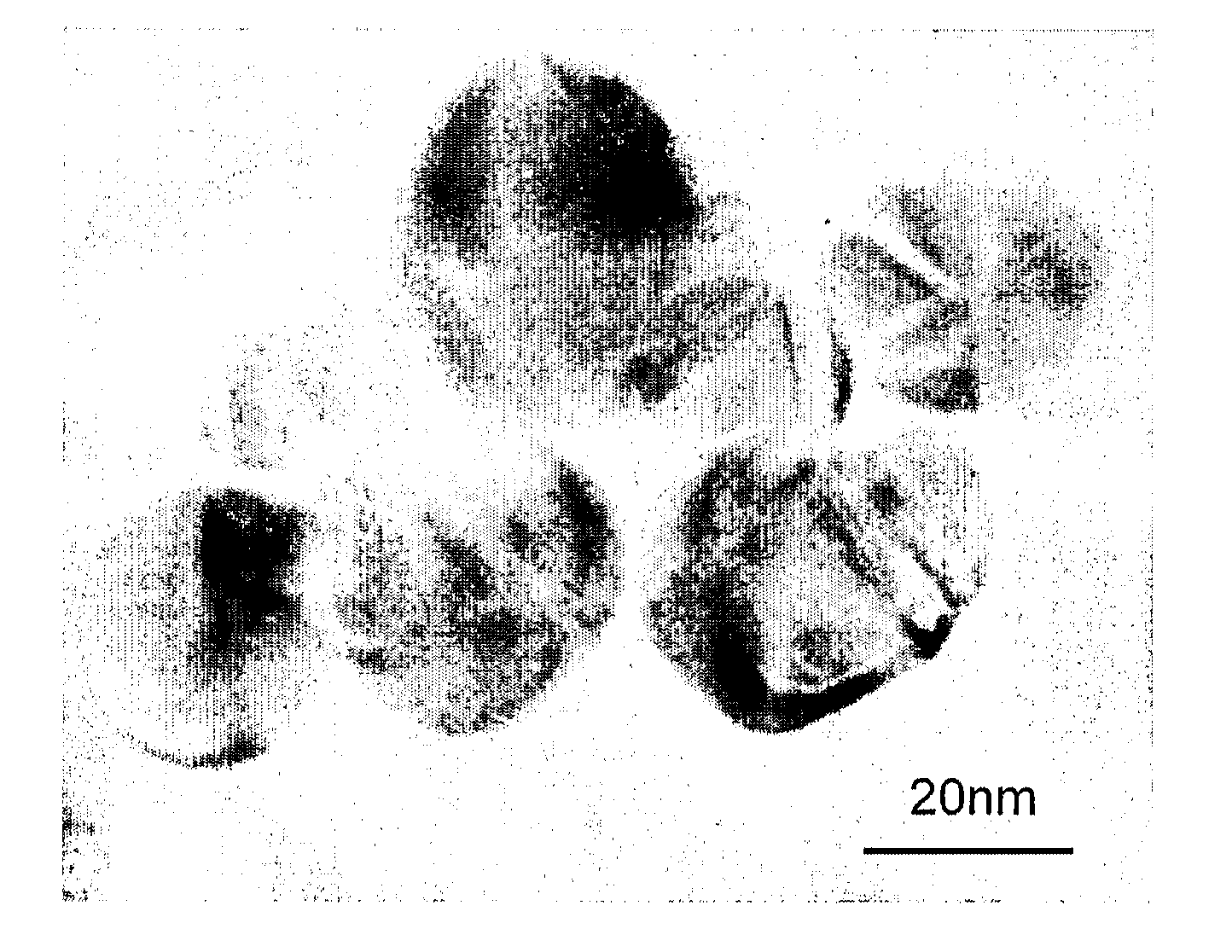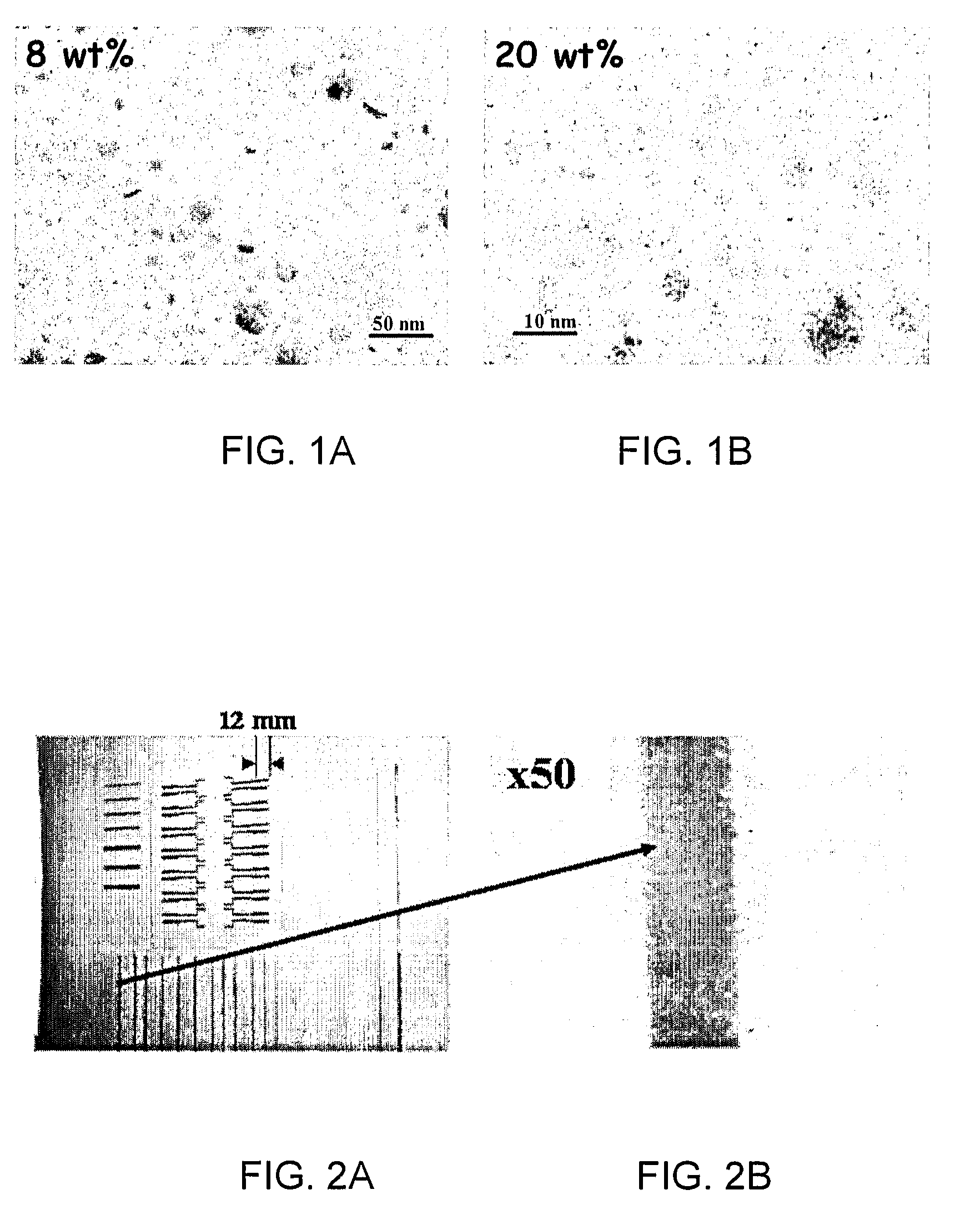Method of forming aqueous-based dispersions of metal nanoparticles
a technology of metal nanoparticles and dispersions, which is applied in the direction of resistive material coating, non-conductive materials with dispersed conductive materials, inks, etc., can solve the problems of oxidation of liquid metal, difficulty in adhesion of droplets to a substrate, and time-consuming and expensive processes of microfabrication of such structures by lithographic and electroless techniques
- Summary
- Abstract
- Description
- Claims
- Application Information
AI Technical Summary
Benefits of technology
Problems solved by technology
Method used
Image
Examples
examples
1. Preparation of Silver Nanodispersions Via Silver Salt Suspension
examples 1-3
Materials and Reagents
Polypyrrole, 5% aqueous solution (PPy)
Silver acetate (AgAc)
Dispersing agent Solsperse 40,000 (Avecia, England)
Triple distilled water (TDW)
[0225]
Silver acetate99%Sigma-CAS 563-63-3AldrichPPy (Polypyrrole)Doped, 5 wt %AldrichCAS 30604-81-0solution in waterAcsorbic acid99%SigmaCAS 50-81-7Solsperse 40,00084.1% Avecia
Instruments:
Hot plate with a stirrer
Centrifuge (Sorvall superspeed RC2-B)
Ultrasound bath (42 kHz)
DSL (Dynamic Light scattering) (Malvern HPPS / NanoSizer)
Oven for heating at 600° C.
Stock Solutions:
Ascorbic acid 30 wt %
Solsperse 40000 5 wt %
Example 1
Procedure
Nucleation step: 1 g of AgAc was added to 10.605 ml of TDW in a 28 ml vial. The vial was heated in a hot bath to 95° C. while stirring. After 5 min of stirring, 0.32 g of Ppy (5 wt %) was added.
[0226]Reaction. 15 min after addition of PPy, 0.865 g of ascorbic acid (30 wt %) was added, and reaction mixture was heated at 95° C. for 5 min while stirring and then was cooled in ice bath. A spo...
examples 4-5
Materials and Reagents
Sokalan HP80
Silver acetate (AgAc)
Dispersing agent Solsperse 40,000 (Avecia, England)
Triple distilled water (TDW)
[0229]
Silver acetate99%Sigma-CAS 563-63-3AldrichSokalan HP8040 wt % solution inBASFwaterAcsorbic acid99%SigmaCAS 50-81-7Solsperse 40,00084.1% Avecia
Instruments:
Hot plate with a stirrer
Centrifuge (Sorvall superspeed RC2-B)
Ultrasound bath (42 kHz)
DSL (Dynamic Light scattering) (Malvern HPPS / NanoSizer)
Oven for heating at 600° C.
Stock Solutions:
Ascorbic acid 15 wt %
Ascorbic acid 30 wt %
Solsperse 40000 5 wt %
Sokalan HP80 50 wt %
Example 4
Procedure
Nucleation step: 1 g of AgAc was added to 5.3 ml of TDW in a 28 ml vial. The vial was heated in a hot bath to 95° C. while stirring. After 5 min of stirring, 3.26 g of Sokalan HP80, 50 wt %, was added.
Reaction: 5 min after addition of Sokalan HP80, 3.46 g of ascorbic acid (15 wt %) was added, and reaction mixture was heated at 95° C. for 5 min while stirring and then was cooled in the ice bath.
[0230]S...
PUM
| Property | Measurement | Unit |
|---|---|---|
| temperature | aaaaa | aaaaa |
| temperature | aaaaa | aaaaa |
| diameter | aaaaa | aaaaa |
Abstract
Description
Claims
Application Information
 Login to View More
Login to View More - R&D
- Intellectual Property
- Life Sciences
- Materials
- Tech Scout
- Unparalleled Data Quality
- Higher Quality Content
- 60% Fewer Hallucinations
Browse by: Latest US Patents, China's latest patents, Technical Efficacy Thesaurus, Application Domain, Technology Topic, Popular Technical Reports.
© 2025 PatSnap. All rights reserved.Legal|Privacy policy|Modern Slavery Act Transparency Statement|Sitemap|About US| Contact US: help@patsnap.com



